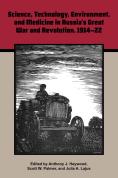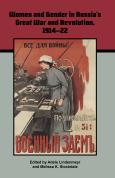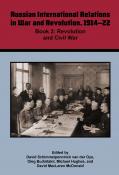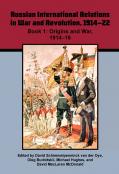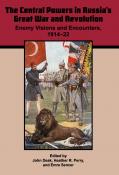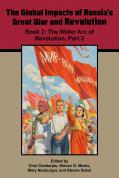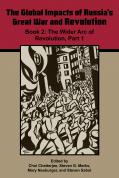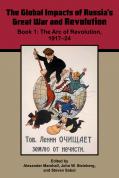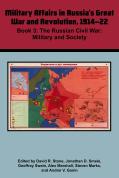Long overlooked in the established literature, historical investigations of Russian Science, Technology, Environment, and Medicine (STEM) have recently benefitted from newfound interest among academic specialists. Informed by a broad range of innovative methodological and theoretical approaches, historians from the US, Europe, and Russian Federation have turned their attention to exploring the myriad political, cultural, social, and economic factors that shaped (and were shaped by) developments in these fields. This installment of the series Russia's Great War and Revolution aims to promote further understanding of Russia's unique contributions to STEM-related fields by documenting and analyzing the complex transformations occasioned by the country's “continuum of crisis” during the years c. 1914–24. In addition to introducing English-speaking audiences to important but otherwise little-known figures and events from the Russian past, this volume's 16 chapters shed new light on longstanding debates regarding the country’s path to modernization; the contributions of its technical and scientific experts; and the extent to which the institutions and methods adopted by Soviet leaders were built upon foundations established by their imperial predecessors. The collection makes significant contributions to multiple fields of inquiry; its authors’ findings and perspectives can be expected to influence scholarly agendas and public understanding for years to come.
Russia's Great War & Revolution Series
Series Information
Series: Russia’s Great War and Revolution
Editors: Anthony Heywood, David MacLaren McDonald, John W. Steinberg
DOI: 10.52500/RMBM3333
https://doi.org/10.52500/RMBM3333
For most of the twentieth century Russia’s Great War of 1914-18 was a historical afterthought. Overshadowed by the Bolsheviks’ revolution, the Civil War, and the consolidation of Soviet power, the First World War suffered from relative neglect within professional scholarship, as Soviet and Western experts alike focused their energy on explaining either the decline and fall of the autocracy or the origins and rise of Russian Communism.
Since the early 1990s, however, researchers in Russia and elsewhere have started to re-examine and re-evaluate the war’s significance and meaning in the history of that state and society. Encouraged by the opening of access to the Russian archives and freed from the ideological baggage of earlier historical debates, they have begun to investigate and reassess Russia’s Great War not simply as a prelude to “Red October,” but in its own right. Increasingly, the war is seen as the fulcrum which set into motion a chain of events that transformed Eurasia and much of the world. Instead of treating “1917” as a watershed moment in Russian and global history, many scholars now perceive a "continuum of crisis" between 1914 and the early 1920s.
In the years preceding the one-hundredth anniversary of the First World War interest in Russia’s involvement became much more engaged not just among scholars, but also in public discussions among Russian leaders and citizens. The centennial of the war’s outbreak also challenged historians of Russia to raise public awareness of Russia's contributions to the Great War and of the war’s impacts on Russia. In response, Slavica’s series “Russia's Great War and Revolution” was conceived in 2006 as a long-term project to promote and disseminate such research. With over 250 contributing authors from across the globe and a projected total of 11 volumes with 20 individual books, it has become unquestionably the biggest multinational scholarly effort to mark the War’s centennial in relation to Russia. It seeks to provide readers of English with a broader understanding of the war’s place in Russian history and, as important, the place of Russia’s involvement in the history of the Great War and its consequences.
Volumes in Print
Vol. 1 Culture
Vol. 2 Empire and Nationalism
Vol. 3 The Home Front
Vol. 4 The Far East
Vol. 5 Military Affairs (Books 1, 2, & 3)
Vol. 6 Global Impacts
Vol. 7 Central Powers
Vol. 8 International Relations
Vol. 9 Personal Trajectories
Vol. 10 Women and Gender
Vol. 11 Science, Technology, Environment, and Medicine
Planned Volumes:
Vol. 5 Military Affairs (Books 4 & 5)
Book Reviews
Review of Book 1 in Acta Historica Universitatis Klaipedensis, vol. 32.
World War I, followed by four more years of revolution and civil conflict, exerted its power to both liberate and destroy in Russia on a scale unsurpassed elsewhere in Europe. It accelerated improvements in women’s status and employment opportunities, culminating with the gain of full political rights after the overthrow of the monarchy in February 1917. The Bolshevik Revolution in October 1917 ushered in a new leadership and political system that proclaimed sweeping economic and social equality for women as its goal, not mere “bourgeois” rights. At the same time, war and revolution subjected women and men to extreme violence and insecurity and upended gender expectations. Individual historians have investigated various problems in the history of women and gender in Russia during this period, but the field still lags behind the extensive historiography of gender and war in Europe.
This volume brings together scholars from Russia, Great Britain, and North America to examine women’s experiences and changing gender norms during Russia’s crisis years. Looking beyond rhetoric about women’s wartime service and ideological proclamations of emancipation, the authors seek to understand how years of military combat, political upheaval, and social transformation affected lives and redefined concepts of citizenship, patriotism, and gender. Since no one volume can encompass the vast scope and depth of these topics, the contributors hope that their work will encourage others to undertake research on women and gender in Russia’s Great War and Revolution.
Adele Lindenmeyr and Melissa K. Stockdale, Introduction
https://doi.org/10.52500/YNQH7079
Anthony J. Heywood, Women Workers in Wartime Tsarist Russia, 1914–17: Hiring Policy in the Railroad Industry
https://doi.org/10.52500/SRPZ5718
Denis Davydov and Olga Kozlova, Emancipation “Soviet-style”: Changes in the Status of Rural Women, 1914–27 (Based on Materials from Kazan´ Province and the Tatar Republic)
https://doi.org/10.52500/KRLT2463
Aleksandr Borisovich Astashov, Women’s Labor on Russia’s Defense in the First World War: Work and Gender
https://doi.org/10.52500/UVOB9715
Christine D. Worobec, Lived Religion Gendered: Representations and Practices of Russian Orthodoxy
https://doi.org/10.52500/UFGQ4627
Katherine McElvanney, Women and the Early Soviet Press
https://doi.org/10.52500/PQGH5270
Ronald P. Bobroff, En Garde! The Influence of Elite Masculinity on Russia’s Decision for War in July 1914
https://doi.org/10.52500/MRZZ2203
Steven G. Jug, Reconnoitering Masculine Subjectivities among Soldiers and Officers on Russia’s Military Fronts, 1914–17
https://doi.org/10.52500/YAZA7059
Boris I. Kolonitskii, Kerenskii as a “Woman”: The Delegitimization of a Politician in the Conditions of Revolution
https://doi.org/10.52500/FDTI2554
Pavel Vasilyev, Gendered Bodies on Trial: Exploring Litigation Strategies in the Early Soviet People’s Court
https://doi.org/10.52500/GRLV3532
Galina Ulianova, The Dowager Empress Mother Mariia Fedorovna during Russia’s Great War and Revolution
https://doi.org/10.52500/UQTF4501
David Borgmeyer, The Art of Natal´ia Goncharova and the Great War: Modernism and Conflict in Russia
https://doi.org/10.52500/IXTA7019
Stuart Finkel, Philanthropy, Politics, and Public Action: Ekaterina Peshkova in Wartime and Revolution
https://doi.org/10.52500/TVUL9560
Katy Turton, Gender, Political Culture, and the February Revolution
https://doi.org/10.52500/MURL9941
Olga Volkova, Two Voices from Russian Harbin: Gender Fluidity and Heroic Rhetoric in the Poetry of Arsenii Nesmelov and Marianna Kolosova
https://doi.org/10.52500/THRA5286
Karen Petrone, Gender and Civil War (1918–21) in Contemporary Russian Memory
https://doi.org/10.52500/NJCQ9185
Susan R. Grayzel, Situating Russia’s Great War and Revolution in the History of First World War Women and Gender
https://doi.org/10.52500/DQUP2796
This volume investigates how the revolutionary events of 1917–21 shaped biographies both in Russia and Western Europe and how people tried to make sense of the political developments during these years in self-testimonies like diaries and memoirs. What was the impact of individuals on the course of the revolution? What do we know about the personal experiences during 1917 of revolutionary activists, victims, and bystanders? What are the specific features of autobiographical texts and ego-documents from the time of Russia’s Great War and Revolution? The essays of this volume examine a plurality of stories, perceptions, and interpretations. They analyze the trajectories of men and women with very different origins and social backgrounds. Among them are members of the “old elite” who personally experienced the Russian Revolution of 1917 and were forced into exile after the victory of the Bolsheviks in the October Revolution and the Civil War. Moreover, in this volume protagonists who actively supported the revolution and “ordinary people” who neither belonged to the old elite nor were politically committed stand in focus. Finally, the construction of revolutionary narratives and memories is addressed. The case studies presented here allow us to critically evaluate established master narratives about the Russian Revolution and the Civil War. They also enable us to point out the contrast between historical caesuras and the continuity of personal lives, to explore geographical mobility and developments beyond the political centers, to give a voice to historically marginal actors, and to juxtapose our concept of “history” with the many-voiced chorus of individual experiences.
Korine Amacher and Frithjof Benjamin Schenk, Introduction
https://doi.org/10.52500/GLLS9317
Adele Lindenmeyr, “Common Sense Vanishes in Revolutionary Times”: Sof´ia Panina and Ariadna Tyrkova-Williams Reflect on 1917
https://doi.org/10.52500/PBKK9855
Henning Lautenschläger, Too Busy for Nostalgia? Sergei Prokudin-Gorskii’s Professional Life and Autobiographical Publications after the Revolution (1917–44)
https://doi.org/10.52500/FIYX3553
Fabian Baumann, Dragged into the Whirlwind: The Shul´gin Family, Kievlianin, and Kiev’s Russian Nationalist Movement in 1917
https://doi.org/10.52500/JHDB7956
Frithjof Benjamin Schenk, “I Am Too Bewildered to Understand Anything These Days”: Members of the Old Elite Try to Make Sense of the Russian Revolutions
https://doi.org/10.52500/VEZJ7946
Christopher Read, The Kurbatikha Estate: Revolution in One Manor. Mature Reflections on Childhood Experience
https://doi.org/10.52500/RNVH5182
Sophie Cœuré, Two Women Gaining Power Through the October Revolution: Aleksandra Kollontai and Suzanne Girault
https://doi.org/10.52500/CORV6026
Korine Amacher, Experiences of War and Revolution: Vladimir Socoline’s Long Road to Damascus
https://doi.org/10.52500/CSIS9655
Anthony J. Heywood, Facing the Rubicon: Analyzing the Impact of the Russian Revolution on an Individual Life
https://doi.org/10.52500/OMAK1025
Marina Yu. Sorokina, Roman Iakobson and the Russian Revolution
https://doi.org/10.52500/JFEZ5207
Igor Narsky and Aleksandr Fokin, “We’re Growing Accustomed to Heaven on Earth”: Diaries as a Means of Self-Preservation, and a Testimony to Means of Survival, in Revolutionary Russia
https://doi.org/10.52500/VYTQ4719
Julia Herzberg, An Event without Importance? Peasant Autobiographical Writing as Media of the 1917 October Revolution
https://doi.org/10.52500/VYTQ4719
Alexis Pogorelskin, Kamenev in Conflict with Lenin and Trotskii: The Perils of Revolutionary Biography
https://doi.org/10.52500/CXUP1211
Éric Aunoble, Polish Leftists in the Russian Revolution in Ukraine: The Difficult Construction of a Soviet Memory
https://doi.org/10.52500/YYQH3511
Alexander V. Reznik, Lev Trotskii’s Experiences of Autobiography: My Life and Its Antecedents
https://doi.org/10.52500/CPLS7449
Pierre Boutonnet, Volin, a Revolutionary in Exile: The Function of His Personal Testimony
https://doi.org/10.52500/CBET4948
Historians devote a great deal of attention to the diplomacy that led Russia into the Great War, but have tended to neglect the course of this diplomacy once the fighting erupted. This volume addresses that lacuna with a broad range of essays examining the foreign relations of the empire, as well as its republican and early Soviet successors, from the July 1914 Crisis to the end of the Civil War in 1922. Written by distinguished and emerging scholars from North America, Europe, Russia, and Japan, the essays make abundant use of Russian archival collections, largely inaccessible until the 1990s, to reassess the conjectures and conclusions previously drawn from other sources. While some chapters focus on traditional “diplomatic” history, others adopt new “international history” by placing Russia’s relations with the world in their social, intellectual, economic, and cultural contexts. Arranged in roughly chronological order, the first volume covers the late imperial period, from 1914 through mid-1916, while the second proceeds through the revolutions of 1917 and the Civil War, up to the end of that conflict in 1922. Together, these books’ comments should foster a renewed appreciation for international relations as a central element of Russia’s Great War and Revolution.
Michael Hughes, From the February Revolution to the Treaty of Brest-Litovsk
https://doi.org/10.52500/PPBE3643
Norman E. Saul, The United States and Russia in the Turmoil of War and Revolution, 1914–18
https://doi.org/10.52500/CNJF3673
Liudmila Sultanovna Gatagova, The Global War in Russian Patriotic Literature, 1914–15
https://doi.org/10.52500/VVGU6668
Thomas Bürgisser, Flight to Neutral Territory: Escaped Russian POWs and Deserters in Switzerland
https://doi.org/10.52500/LLXC9908
Marina Soroka, Family Networks in a Divided Europe: The Case of the Benckendorff Family
https://doi.org/10.52500/TLFP2364
John W. Steinberg, The Treaty of Brest-Litovsk: The Wilsonian Moment before Wilson
https://doi.org/10.52500/MSQG7856
Oleg Budnitskii, The Diplomacy of the “Second Russia,” 1918–22
https://doi.org/10.52500/NDNS9115
Alastair Kocho-Williams, The Persistence of Tsarist Diplomacy after the Russian Revolution
https://doi.org/10.52500/ILYD1707
Anatol Shmelev, Foreign Minister Redux: Sergei Dmitrievich Sazonov and White Diplomacy in Paris, 1918–20
https://doi.org/10.52500/NADM7699
Dinah Jansen, Wilsonian Principles and the Defense of Russian Territory at Versailles, 1919
https://doi.org/10.52500/GADD3063
Charlotte Alston, International Intervention in Russia’s Civil War: Policies, Experiences, and Justifications
https://doi.org/10.52500/RWMB2616
Shūsuke Takahara, Woodrow Wilson’s Intervention in North Russia and Siberia
https://doi.org/10.52500/QUXR5641
Oleksa Drachewych, The Bolsheviks’ Revolutionary International: The Idea and Establishment of the Communist International, 1914–22
https://doi.org/10.52500/ANIJ7435
Daniel C. Waugh, Britain Confronts the Bolsheviks in Central Asia: Great Game Myths and Local Realities
https://doi.org/10.52500/ZCXA5036
Taline Ter-Minassian, From the Transcaspian to the Caucasus: Reginald Teague Jones’s Secret War (1918–21)
https://doi.org/10.52500/LVKE6925
Yulia Yurievna Khmelevskaya, “A la Guerre Comme à la Guerre”: America’s Battle with Hunger in Soviet Russia (1921–23)
https://doi.org/10.52500/HKCM5036
Anthony J. Heywood, Russian and Soviet Foreign Trade, 1914–28: Rethinking the Initial Impact of the Bolshevik Revolution
https://doi.org/10.52500/HXIF7628
Historians devote a great deal of attention to the diplomacy that led Russia into the Great War, but have tended to neglect the course of this diplomacy once the fighting erupted. This volume addresses that lacuna with a broad range of essays examining the foreign relations of the empire, as well as its republican and early Soviet successors, from the July 1914 Crisis to the end of the Civil War in 1922. Written by distinguished and emerging scholars from North America, Europe, Russia, and Japan, the essays make abundant use of Russian archival collections, largely inaccessible until the 1990s, to reassess the conjectures and conclusions previously drawn from other sources. While some chapters focus on traditional “diplomatic” history, others adopt new “international history” by placing Russia’s relations with the world in their social, intellectual, economic, and cultural contexts. Arranged in roughly chronological order, the first volume covers the late imperial period, from 1914 through mid-1916, while the second proceeds through the revolutions of 1917 and the Civil War, up to the end of that conflict in 1922. Together, these books’ comments should foster a renewed appreciation for international relations as a central element of Russia’s Great War and Revolution.
David MacLaren McDonald, Introduction
https://doi.org/10.52500/UTGI6993
David Schimmelpenninck van der Oye, The Historiography of Russian International Relations during the Great War and Revolution
https://doi.org/10.52500/SWZE7383
Dominic Lieven, Russia against Napoleon and Wilhelm: Explaining Success and Failure
https://doi.org/10.52500/LDYM8120
David MacLaren McDonald, From Tsushima to the July Crisis
https://doi.org/10.52500/HRYX6681
Marina Soroka, The Russian Foreign Ministry in War and Revolution
https://doi.org/10.52500/KRMX6802
Irina Sergeevna Rybachenok, Russian Foreign Policy at the Turn of the 20th Century: Goals, Challenges, and Methods
https://doi.org/10.52500/TAGF9628
Elizabeth Greenhalgh, Managing a “Long-Distance” Coalition War: France and Russia, 1914 to Early 1917
https://doi.org/10.52500/WUJO9882
Keith Neilson, Anglo-Russian Relations in the First World War
https://doi.org/10.52500/KKZJ7629
Sean Gillen, “A Great Russia”: The State of a Free, Disciplined Nation, 1904–14
https://doi.org/10.52500/WGCJ2199
David Schimmelpenninck van der Oye, From the Guns of August to Sazonov’s Fall
https://doi.org/10.52500/YDSH1036
Jennifer Siegel, Foreign Finance and Russia’s War Effort
https://doi.org/10.52500/TNJQ2448
Ronald P. Bobroff, The Question of the Turkish Straits during World War I
https://doi.org/10.52500/QEAF8183
T. G. Otte, The Waning of the Monarchies: War, Revolution, and Royal Diplomacy
https://doi.org/10.52500/GFBZ4374
Evgenii Iur´evich Sergeev, Russian Military Intelligence in the Coalition War, 1914–18
https://doi.org/10.52500/DIPZ6381
Kirill Andreevich Solov´ev, The State Duma and Russian Foreign Policy in the Great War
https://doi.org/10.52500/KNXU4640
Alexander Polunov, The Russian Orthodox Church in Years of War: International Activity and Plans for Postwar Reconstruction
https://doi.org/10.52500/GVMP7865
Aleksandr Vladimirovich Golubev and Ol ́ga Sergeevna Porshneva, The Image of the Ally in Russian Public Consciousness in the Context of World War I
https://doi.org/10.52500/CUTI6940
Tatiana Filippova, Pickelhaube and Fez: The German and the Turk in Russian Satirical Journals during the Great War
https://doi.org/10.52500/TRQU6767
Alexandre Sumpf, Defining Enemy Atrocities: Krivtsov’s Extraordinary Commission
https://doi.org/10.52500/XLYZ3657
Wim Coudenys, High Politics in a Small Country: Belgian-Russian Military Relations in War and Revolution
https://doi.org/10.52500/UNAZ4484
This volume brings together the work of researchers in North America, Central and Eastern Europe, and Turkey, who are generating important, archivally based scholarship in their respective fields, languages, and nations of study. The larger goal of this volume is to sit in conversation with the others in this series that directly deal with Russia and its Great War and Revolution. Therefore, the volume provides an entry point for scholars who need a quick assessment of recent historiographic perspectives from the “other side of the hill.” The aim is to introduce readers to the myriad ways that the populations of the Central Powers nations both perceived and encountered Russia’s Great War and Revolution. The volume has been organized around four key areas in order to give the reader a glimpse into new lines of research on the war experience of the Central Powers. The first section looks at the ways in which Russia appeared in the eyes of others. The Central Powers went to war against Russia with their own preconceived notions. How those notions changed when put in the pressure cooker of violence, invasion, and occupation forms a crucial point for understanding Russia in the imagination of the people and elites in Germany, Austria-Hungary, and the Ottoman Empire. The war also brought peoples into direct contact. The second section examines the variety of borderland encounters: positive, negative, and ambiguous. Ethnic violence and atrocity is certainly one aspect of those encounters which needs telling. But the war also opened up new spaces for economic exploitation and fraternization that colored and shaped the experiences of the soldiers and civilians. Section 3 focuses on the big-picture mechanics of strategy and policy. Armies in this new era of warfare increasingly functioned as administrators—of occupation regimes, veteran programs, and as quartermasters of the entire war economy. The chapters here explore the facets of military policy toward the end of the formal fighting in the war. And finally, the fourth section speaks to the transformation of the war in the East and its legacy for the continuum of violence that succeeded formal hostilities.
John Deak, Heather R. Perry, and Emre Sencer, Introduction: Russia’s Great War and Revolution, the Central Powers
https://doi.org/10.52500/GTGF8954
Stephan Lehnstaedt, Pride and Prejudice: The Central Powers’ Images of Poles and Jews, 1915–18
https://doi.org/10.52500/SOLK9863
Troy R. E. Paddock, The Threat from the East
https://doi.org/10.52500/UETZ5795
Alexander Will, Beating Russia in the Periphery: Austria-Hungary in the Middle East, 1914–18
https://doi.org/10.52500/DVQV1447
Yiğit Akın, “The Greatest Enemy of the Ottomans and Muslims”: The Russians in Ottoman Propaganda during the First World War
https://doi.org/10.52500/VQDG4021
Elke Hartmann, Dashed Hopes: Perspectives of Ottoman-Armenian Elites on Russia
https://doi.org/10.52500/HBBQ9929
Jesse Kauffman, Nationalism, Imperialism, and Occupation in the Shatterzone of Empires: Russia’s Western Frontier, 1905–18
https://doi.org/10.52500/JNKT6627
Christian Westerhoff, New Forms of Recruitment? German Labor Policy in the Occupied Territories of the Russian Empire, 1917–18
https://doi.org/10.52500/KZHA9650
Candan Badem, Rethinking Russian Influence: Religious and Ethnic Violence in the Southwest Caucasus in World War I
https://doi.org/10.52500/IAPC7337
Yücel Yanıkdağ, Flirting with the Enemy: Ottoman Prisoners of War and Russian Women during the Great War
https://doi.org/10.52500/YRAO5709
David Hamlin, Economic War and Economic Peace: Germany Reconstructs an Economic Order in Ukraine and Romania, 1918
https://doi.org/10.52500/KSZQ5982
Peter Lieb, German Politics in the East between Brest-Litovsk and Versailles
https://doi.org/10.52500/ZAJC4248
Robert L. Nelson and Justin Fantauzzo, Soldiers as Settlers in East Central Europe during and in the Wake of the Great War
https://doi.org/10.52500/RTJW4131
Verena Moritz and Hannes Leidinger, The Influence of the Russian Revolutions on the POWs in Austria-Hungary and Russia
https://doi.org/10.52500/OIVG4816
Wolfram Dornik, Between Military Pragmatism and Colonial Fantasies: Intervention and Occupation in Eastern Europe, 1914–19
https://doi.org/10.52500/NXOW5580
The Russian Revolution of 1917 was quickly perceived by both contemporaries and subsequent scholars as not merely a domestic event within the Russian Empire, but as a systemic crisis that fundamentally challenged the assumptions underpinning the existing international system. The revolution posed striking challenges not merely to conventional diplomacy, with the Bolsheviks openly seeking to end the war, spark international revolutionary class war, and vocally backing national self-determination for formerly subject peoples, but to existing social, economic, and ethnic orders. From nomadic peoples in Mongolia and the Central Asian steppe suddenly juggling new dilemmas of greater autonomy or full independence, to German workers, soldiers, and sailors challenging their traditional rulers, or Turkish politicians seeking to build a viable new nation state from the rubble of the Ottoman Empire, there were few political developments anywhere in the world in 1917–24 not directly or indirectly influenced by the Russian Revolution. The Arc of Revolution, which is Book 1 in the RGWR volume The Global Impacts of Russia's Great War and Revolution, examines the reverberations of the Russian Revolution in the geographically contiguous imperial borderlands traditionally contested between Imperial Russia and its geopolitical rivals—the terrain stretching from Finland, through Central Europe to the Transcaucasus and Central Asia. Books 2 and 3 in the volume examine the wider global impact of the revolution in regions of the world noncontiguous with Russia itself, from North and South America to Asia, Africa, Australia, and various parts of Europe. The emphasis in Books 2 and 3, The Wider Arc of Revolution, is on the complex emotional appeal and ideological legacies of Russian communism, including anticommunism, evidenced well into the 20th century.
Erik Ching and José Alfredo Ramírez, El Salvador and the Russian Revolution, 1917–32
https://doi.org/10.52500/MLJF2325
Ben Curtis, Incorrigible Rebels: The Significance and Influence of the Communist Party in the South Wales Coalfield, 1917–36
https://doi.org/10.52500/XCZX1691
Sandra McGee Deutsch, “A Labor Filled with Love”: Communists, Women, and Solidarity in Argentina, 1930–47
https://doi.org/10.52500/NDSW8412
William Kenefick and Paul Dukes, The Scottish Radical Left in Aberdeen and Dundee: The Impact of the Great War and Russian Revolution
https://doi.org/10.52500/KGIE9090
Daniel Kowalsky, Looking Back on Operation X: Stalin and the Spanish Republic, 1936–39
https://doi.org/10.52500/LJRE9285
Stuart Macintyre, Revolution from Afar: Communism in Australia
https://doi.org/10.52500/LXZB9582
Jie-Hyun Lim, Nationalizing the Bolshevik Revolution Transnationally: Non-Western Modernization among “Proletarian” Nations
https://doi.org/10.52500/CVRN6908
Afshin Matin-asgari, The Bolshevik Revolution’s Impact on Iranian Modernity
https://doi.org/10.52500/IFWL7462
Kristin Mulready-Stone, The Impact of the Russian Revolution on the Chinese Youth Movement
https://doi.org/10.52500/YAWB8130
Michael Silvestri, “Those Dead Heroes Did Not Regret the Sacrifices They Made”: Responses to the Russian Revolution in Revolutionary Ireland, 1917–23
https://doi.org/10.52500/HMLT6020
Rianne Subijanto, Communist Openbare Vergaderingen and an Indonesian Revolutionary Public Sphere
https://doi.org/10.52500/QTAC6021
Hari Vasudevan, India and the October Revolution: Nationalist Revolutionaries, Bolshevik Power, and “Lord Curzon’s Nightmare”
https://doi.org/10.52500/JVDY6410
Jeffrey Wasserstrom and Yidi Wu, The Russian Revolution through Chinese Eyes, 1917–2017
https://doi.org/10.52500/ILES1665
Lisa A. Kirschenbaum, Reframing Slavic Studies and the Global Impacts of 1917
https://doi.org/10.52500/HUEY3917
Glennys Young, Conclusion: Wider Arcs of the Russian Revolution as Impact, Networks, or ...?
https://doi.org/10.52500/DJVI3568
The Russian Revolution of 1917 was quickly perceived by both contemporaries and subsequent scholars as not merely a domestic event within the Russian Empire, but as a systemic crisis that fundamentally challenged the assumptions underpinning the existing international system. The revolution posed striking challenges not merely to conventional diplomacy, with the Bolsheviks openly seeking to end the war, spark international revolutionary class war, and vocally backing national self-determination for formerly subject peoples, but to existing social, economic, and ethnic orders. From nomadic peoples in Mongolia and the Central Asian steppe suddenly juggling new dilemmas of greater autonomy or full independence, to German workers, soldiers, and sailors challenging their traditional rulers, or Turkish politicians seeking to build a viable new nation state from the rubble of the Ottoman Empire, there were few political developments anywhere in the world in 1917–24 not directly or indirectly influenced by the Russian Revolution. The Arc of Revolution, which is Book 1 in the RGWR volume The Global Impacts of Russia's Great War and Revolution, examines the reverberations of the Russian Revolution in the geographically contiguous imperial borderlands traditionally contested between Imperial Russia and its geopolitical rivals—the terrain stretching from Finland, through Central Europe to the Transcaucasus and Central Asia. Books 2 and 3 in the volume examine the wider global impact of the revolution in regions of the world noncontiguous with Russia itself, from North and South America to Asia, Africa, Australia, and various parts of Europe. The emphasis in Books 2 and 3, The Wider Arc of Revolution, is on the complex emotional appeal and ideological legacies of Russian communism, including anticommunism, evidenced well into the 20th century.
Choi Chatterjee, Introduction: The Global Impact of 1917
https://doi.org/10.52500/RMTM6091
David MacLaren McDonald, Dreams of Dukhoboriia: The Russian Revolution and Canada’s Dukhobors
https://doi.org/10.52500/RMTM6091
Mary Neuburger, Hungry for Revolution: Women, Food, and the Bulgarian Left, 1917–23
https://doi.org/10.52500/DSAW9571
Erik van Ree, A Dream Come True: Western Eyewitnesses of the October Revolution
https://doi.org/10.52500/NQWU7244
Robert Weinberg, The Bolshevik Revolution and Jews
https://doi.org/10.52500/NKHF4857
Jürgen Buchenau, A “Bourgeois Revolution” Contemplates a “Worker’s Revolution:” Mexico, 1917–34
https://doi.org/10.52500/DWAH3382
A. James Gregor, The Bolshevik Revolution and the Rise of Italian Fascism
https://doi.org/10.52500/SIHO5230
Sabine Hake, Communists into Nazis: The Conversion of the German Worker
https://doi.org/10.52500/TUMA3009
Steven G. Marks, “Workers of the World Fight and Unite for a White South Africa”: The Rand Revolt, the Red Scare, and the Roots of Apartheid
https://doi.org/10.52500/AGOE7356
Steven Sabol, An Uncivil War: The Red Scare in the United States
https://doi.org/10.52500/YSOJ4715
Choi Chatterjee, Lady in Red: Russian Revolutionary Languages in the American Imagination, 1917–39
https://doi.org/10.52500/ENMP9632
Ali İğmen, Between Empire and the Nation-State, between Humanism and Communism: Nâzım Hikmet’s Noble Struggle with Modernity
https://doi.org/10.52500/SLRP5372
Masha Kirasirova, An Egyptian Communist Family Romance: Revolution and Gender in the Transnational Life of Charlotte Rosenthal
https://doi.org/10.52500/ZIZG5461
Lisa A. Kirschenbaum, Michael Gruzenberg/Mikhail Borodin: The Making of an International Communist
https://doi.org/10.52500/WORP5695
Julia L. Mickenberg, An American Flapper in Russia? Work, Desire, and Dissent in 1920s Moscow
https://doi.org/10.52500/LQDX5438
Sandra Pujals, Becoming Jaime Nevares: Imagination and Identity Reinvention in the Communist International’s Latin American Network, 1919–43
https://doi.org/10.52500/WROA8136
Ludmila Stern, A Woman with a Camera: Soviet Espionage in Interwar France
https://doi.org/10.52500/ZZUC2200
The Russian Revolution of 1917 was quickly perceived by both contemporaries and subsequent scholars as not merely a domestic event within the Russian Empire, but as a systemic crisis that fundamentally challenged the assumptions underpinning the existing international system. The revolution posed striking challenges not merely to conventional diplomacy, with the Bolsheviks openly seeking to end the war, spark international revolutionary class war, and vocally backing national self-determination for formerly subject peoples, but to existing social, economic, and ethnic orders. From nomadic peoples in Mongolia and the Central Asian steppe suddenly juggling new dilemmas of greater autonomy or full independence, to German workers, soldiers, and sailors challenging their traditional rulers, or Turkish politicians seeking to build a viable new nation state from the rubble of the Ottoman Empire, there were few political developments anywhere in the world in 1917–24 not directly or indirectly influenced by the Russian Revolution. The Arc of Revolution, which is Book 1 in the RGWR volume The Global Impacts of Russia's Great War and Revolution, examines the reverberations of the Russian Revolution in the geographically contiguous imperial borderlands traditionally contested between Imperial Russia and its geopolitical rivals—the terrain stretching from Finland, through Central Europe to the Transcaucasus and Central Asia. Books 2 and 3 in the volume examine the wider global impact of the revolution in regions of the world noncontiguous with Russia itself, from North and South America to Asia, Africa, Australia, and various parts of Europe. The emphasis in Books 2 and 3, The Wider Arc of Revolution, is on the complex emotional appeal and ideological legacies of Russian communism, including anticommunism, evidenced well into the 20th century.
Alex Marshall, Introduction: Into the Abyss: The Arc of Revolution and the “World Crisis”
https://doi.org/10.52500/PXRV3892
Alex Marshall, Lenin and World Revolution, 1917–24
https://doi.org/10.52500/OCLW5934
Norman Saul, The Helsingfors (Helsinki) Sailors’ Assembly in 1917
https://doi.org/10.52500/ZICN2608
Marko Tikka, Finland’s Civil War of 1918
https://doi.org/10.52500/XVON5309
Karsten Brüggemann, Learning from Estonia Means Learning to Be Victorious? Estonia between the Legacy of the February Revolution and Nikolai Iudenich’s Northwestern Army
https://doi.org/10.52500/ESRT8537
Geoffrey Swain, Starting the World Revolution: Latvia’s Soviet Republic of 1919
https://doi.org/10.52500/XUIA7848
Mark Jones, Scripting the Revolution: “Russian Conditions” and the German Political Imagination in 1918 and 1919
https://doi.org/10.52500/XUIA7848
Thomas Weber, Bavaria’s Seminal Catastrophe: The Revolution of 1918–19
https://doi.org/10.52500/OACH7393
Harald Jentsch, The Hamburg Uprising as Part of the “German October,” 1923
Ignác Romsics, Hungary in 1918–19
https://doi.org/10.52500/IEDH7834
Ignác Romsics, Hungary in 1918–19
https://doi.org/10.52500/SOVW2171
Matthew R. Schwonek, Strategy for an Emerging State: Poland and the War with the Bolsheviks, 1919–21
https://doi.org/10.52500/JERL2106
Jacek Lubecki, Poland and the Russian Revolutions of 1917
https://doi.org/10.52500/PXTS7167
Mark R. Baker, The Russian Revolution in Ukraine and the Ukrainian Revolution of 1917
https://doi.org/10.52500/UZJS5369
Vadim Mukhanov, From the Mountains to the Plains: Establishing Soviet Rule in Armenia and Azerbaijan (1920)
https://doi.org/10.52500/IMKM8423
Vadim Mukhanov, The Final Act of the Civil War in the Caucasus: The Sovietization of Georgia in 1921
https://doi.org/10.52500/MDDG4333
Georgia Eglezou, The Asia Minor War (1919–22)
https://doi.org/10.52500/VRKG9700
Vasil Paraskevov, The Impact of the October Revolution on Bulgarian Politics, 1917–19
https://doi.org/10.52500/ZYZW6263
Steven Sabol, Revolution and Civil War in the Steppe: Alash Orda and the Struggle for Kazakh Independence
https://doi.org/10.52500/ABCI8177
David M. Crowe, Mongolia: Battleground of Eurasian Imperialism, 1911–24
https://doi.org/10.52500/CZUA4883
John W. Steinberg, The Forgotten Treaty of Brest-Litovsk: The Bread Treaty and Peacemaking in 1918
https://doi.org/10.52500/WWEF1438
Steven Sabol, Epilogue
https://doi.org/10.52500/SCYR9728
This book--one of two covering the Russian Civil War in a volume on military affairs during Russia’s Great War and Revolution--explores institutions, social groups, and social conflict amid the chaos of the war that followed the Russian Revolution. Drawing on an international cohort of authors and wide range of newly available sources, the book provides insights into the experience of civil war for those living in the ruins of the Russian Empire. In addition to studies of intelligence and the officer corps of the Red and White armies, it also traces the complicated history of Russia’s Cossacks through the war. Explorations of the role of ideology and propaganda along with the problem of desertion from the fighting armies give insight into the motivations of the war’s soldiers. A series of chapters on peasant insurgency and the anarchic conflicts in Ukraine provide a clearer understanding of often-neglected aspects of the Civil War.
Contents
Andrei V. Ganin, The Russian Officer Corps in the Civil War: The Reds and the National Armies
https://doi.org/10.52500/XUQB3662
Ruslan G. Gagkuev, Russian Officers of the White Movement
https://doi.org/10.52500/DXTQ7293
Andrei V. Ganin, Russian Cossacks in the Civil War
https://doi.org/10.52500/BCUO9253
Stephen Brown, Ideology, Agitation, and Propaganda: The Red and White Armies during the Civil War
https://doi.org/10.52500/JSZO7601
Evgenii O. Naumov, The Struggle Against Desertion on the Red Army’s Eastern Front, 1918
https://doi.org/10.52500/KBBN5032
Andrei V. Ganin, Intelligence and Counterintelligence during the Russian Civil War, 1917–22
https://doi.org/10.52500/KUZN6329
Erik C. Landis, Situating Peasant War, 1918–21
https://doi.org/10.52500/DFJQ1802
Alexander V. Prusin, Otamanshchyna: Insurgency Warfare in Ukraine, 1918–22
https://doi.org/10.52500/XDAD6711
Christopher Gilley, Warlordism in Ukraine: The Otamany during the Russian Civil War
https://doi.org/10.52500/YODV1157
Mykhailo A. Koval´chuk, Ukrainian National Armies in the Russian Civil War, 1917–20
https://doi.org/10.52500/NCCV4353
Andrei V. Ganin, Conclusion: Red Victory
https://doi.org/10.52500/SQUQ7715
Geoffrey Swain, Afterword
https://doi.org/10.52500/UQDW7784




